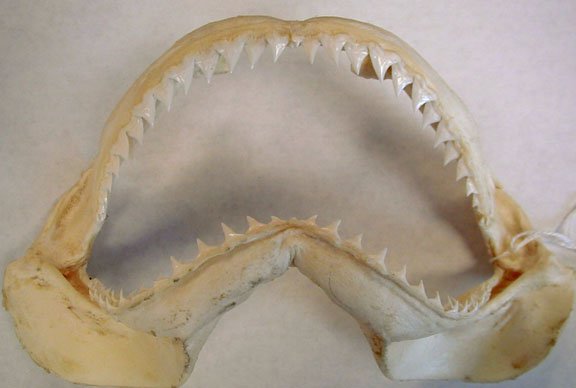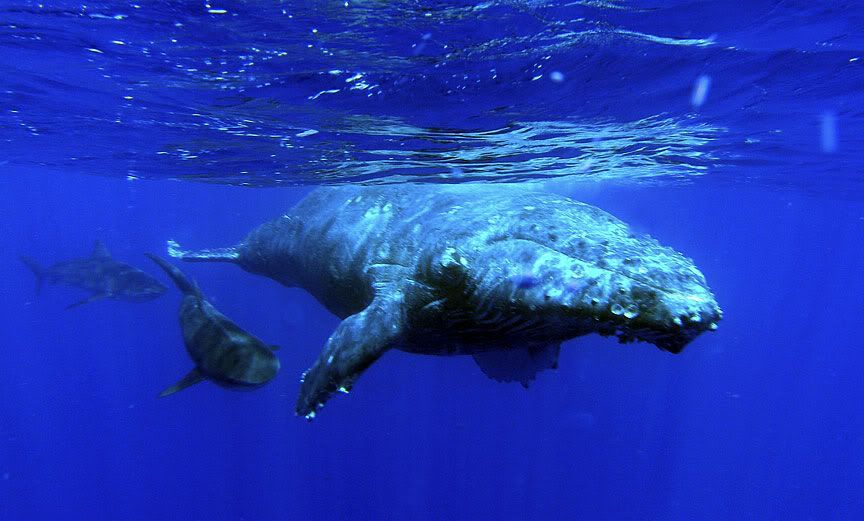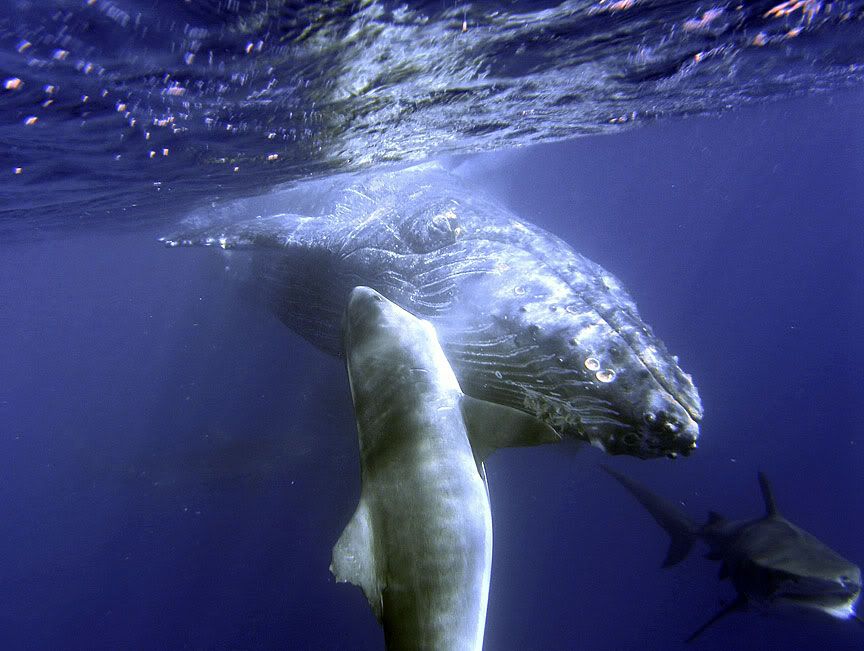Post by Vodmeister on Mar 1, 2014 1:51:20 GMT 5
Galeocerdo cuvier

The tiger shark, Galeocerdo cuvier, one of the largest sharks, is the only member of the genus Galeocerdo. Mature sharks average 3.25 to 4.25 m (10 to 14 ft) and weigh 385 to 635 kg(850 to 1400 lb). It is found in many of the tropical and temperate regions of the world's oceans, and is especially common around islands in the central Pacific. This shark is a solitary hunter, usually hunting at night. Its name is derived from the dark stripes down its body, which fade as the shark matures.
The tiger shark is a dangerous predator, known for eating a wide range of items. Its usual diet consists of fish, seals, birds, smaller sharks, squid and turtles. It has sometimes been found with detritus such as license plates or pieces of old tires in its digestive tract. It is notorious for attacks on swimmers, divers and surfers in Hawaii; and is often referred to as the "bane of Hawaiian surfers" and "the wastebasket of the sea".
The tiger shark is second only to the great white in number of recorded human fatalities and is considered, along with the great white, bull shark and the oceanic whitetip shark to be one of the sharks most dangerous to humans.
Taxonomy
The shark was first described by Peron and Lessueur in 1822 and was given the name Squalus cuvier. Müller and Henle, in 1837 renamed it Galeocerdo tigrinus. The genus, Galeocerdo, is derived from the Greek, galeos which means shark and the Latin cerdus which means the hard hairs of pigs. It is often colloquially called the leopard shark and the man-eater shark.
The tiger shark is a member of the order Carcharhiniformes; members of this order are characterized by the presence of a nictitating membrane over the eyes, two dorsal fins, an anal fin, and five gill slits. It is the largest member of the Carcharhinidae family, commonly referred to as requiem sharks. This family includes some other well known sharks such as the blue shark, lemon shark and bull shark.
Distribution
The tiger shark is often found close to the coast, in mainly tropical and sub-tropical waters, though they can reside in temperate waters. The shark's behaviour is primarily nomadic, but is guided by warmer currents, and it stays closer to the equator throughout the colder months. The shark tends to stay in deep waters that line reefs but does move into channels to pursue prey in shallower waters. In the western Pacific Ocean, the shark has been found as far north as Japan and as far south as New Zealand.
The shark has been recorded down to a depth of 350 m (1085 ft)but is also known to move into shallow water - water that would normally be considered too shallow for a species of its size. It is also frequently found in river estuaries and harbours. At night it is usually found in shallow water.
Anatomy and appearance
Its skin can typically range from a blue or green hue to light with a white or light yellow underbelly. The distinguishing dark spots and stripes are most outstanding in young sharks and fade as the shark matures. Specimens regularly weigh 385 to 635 kg (850 to 1400 lbs). It is usually 3 to 5 m (10 to 16 ft) long, but there have been confirmed specimens as large as 6.4 m (21.5 ft). The heaviest specimen recorded to date, a shark caught in Newcastle, NSW, Australia in 1954 and measuring a mere 5.5 m (18 ft), scaled 1,524 kg (3,360 lb). Sexual maturity is reached at different stages for each of the sexes; males at 2.26 to 2.9 m (7 to 9 ft) whereas females mature at 2.5 to 3.25 m (8 to 10 ft). It has been estimated that the tiger shark can swim at a maximum speed of around 32 km/h (20 mph), with short bursts of higher speeds that last only a few seconds.
The tiger shark's head is somewhat wedge-shaped, which makes it easy for the shark to turn quickly to one side. Tiger sharks, as with other sharks, have small pits on the side of their upper bodies which hold electrical sensors enabling them to detect small muscle movements of other creatures, allowing them to hunt in darkness. A tiger shark generally has long fins and a long upper tail; the long fins act like wings and provide lift as the shark maneuvers through water, whereas the long tail provides bursts of speed. A tiger shark normally swims using lithe movements of its body. Its high back and dorsal fin act as a pivot, allowing it to spin quickly on its alliance.
Its teeth are flat, triangular, notched and serrated. Like most sharks, when a tiger shark loses or breaks one of its teeth, it grows a replacement tooth. The distinctive teeth seem to have evolved to be able to cut through turtle shells, and an adult tiger shark can easily bite through bone.
Diet
Tiger shark at the bottom of Mayan Temple Water Slides at Atlantis.The tiger shark, which generally hunts at night, has a reputation for eating anything it has access to, ignoring what nutritional value the prey may or may not hold. Apart from what is thought to be sporadic feeding, its most common foods include; common fish, squid, birds, seals, other sharks, and sea turtles. The shark has a number of features which make it a good hunter, such as excellent eyesight, which allows for access to murkier waters which can offer more varieties of prey and its acute sense of smell which enable it to react to faint traces of blood in its waters and is able to follow them to the source. The tiger shark's ability to pick up on low-frequency pressure waves produced by the movements of swimming animals, for example the thrashing of an injured animal, enables the shark to find a variety of prey.
The shark is known to be aggressive. The ability to pick up low-frequency pressure waves enables the shark to advance towards an animal with confidence, even in the environment of murky water where it is often found. The shark is known to circle its prey and even study it by prodding it with its snout. When attacking the shark devours all of its prey. Because of its aggressive nature of feeding, it is common to find a variety of foreign objects inside the digestive tract of a tiger shark. Some examples of more unusual items are automobile number plates, petroleum cans, tires, and baseballs. For this reason, the Tiger Shark is often regarded as the ocean's trash can.
Reproduction
The tiger shark breeds by internal fertilization. It is the only species in its family that is ovoviviparous; like mammals, it gives birth to live young. The male tiger shark will insert one of its claspers into the female's genital opening, acting as a guide for the sperm to be introduced. The male uses its teeth to hold the female still during the procedure, often causing the female considerable discomfort. Mating in the northern hemisphere will generally take place between the months of March and May, with the young being born around April or June the following year. In the southern hemisphere, mating takes place in November, December, or early January.
The young are nourished inside the mothers body for up to 14 to 16 months, where the female can produce a litter ranging from 10 to 80 young. A newborn tiger shark is generally 51 to 76 cm long and leaves its mother upon birth. It is unknown how long tiger sharks live, but it has been speculated to be 20 years.
Dangers and conservation
Although shark attacks on humans are a relatively rare phenomenon, the tiger shark is responsible for a large percentage of the fatal attacks that do occur on humans, and is regarded as one of the most dangerous species of sharks. Tiger sharks reside in temperate and tropical waters. They are often found in river estuaries and harbours, as well as shallow water close to shore, where they are bound to come into contact with humans. Because of their curious nature of feeding it is expected that a tiger shark would normally attack a human if it came in contact with it. Tiger sharks are known to dwell in waters with runoff, such as where a river enters the ocean.
Tiger sharks have become a recurring problem in Hawaii and are considered the most dangerous shark species in Hawaiian waters. They are considered to be sacred 'aumakua' or ancestor spirits by the native Hawaiians, however between 1959 and 1976, 4,668 tiger sharks were hunted down in an effort to control what was proving to be detrimental to the tourism industry. Despite these numbers, little decrease was ever detected in the attacks on humans. It is illegal to feed sharks in Hawaii and any interaction with them such as cage diving is discouraged.
The tiger shark is not directly under attack by commercial industries. There is, however, a usual sequence of activities which sees the shark harvested for its fin and flesh. A tiger shark's liver, as with most sharks, is considered to be of high value as it contains a high vitamin A content, which is extracted to produce vitamin A oil. Similar to many other sharks, its skin is a valuable commodity for the handbag industry. A tiger shark's skin is sturdy and considered exotic for its striped tiger-like appearance.
en.wikipedia.org/wiki/Tiger_shark

The tiger shark, Galeocerdo cuvier, one of the largest sharks, is the only member of the genus Galeocerdo. Mature sharks average 3.25 to 4.25 m (10 to 14 ft) and weigh 385 to 635 kg(850 to 1400 lb). It is found in many of the tropical and temperate regions of the world's oceans, and is especially common around islands in the central Pacific. This shark is a solitary hunter, usually hunting at night. Its name is derived from the dark stripes down its body, which fade as the shark matures.
The tiger shark is a dangerous predator, known for eating a wide range of items. Its usual diet consists of fish, seals, birds, smaller sharks, squid and turtles. It has sometimes been found with detritus such as license plates or pieces of old tires in its digestive tract. It is notorious for attacks on swimmers, divers and surfers in Hawaii; and is often referred to as the "bane of Hawaiian surfers" and "the wastebasket of the sea".
The tiger shark is second only to the great white in number of recorded human fatalities and is considered, along with the great white, bull shark and the oceanic whitetip shark to be one of the sharks most dangerous to humans.
Taxonomy
The shark was first described by Peron and Lessueur in 1822 and was given the name Squalus cuvier. Müller and Henle, in 1837 renamed it Galeocerdo tigrinus. The genus, Galeocerdo, is derived from the Greek, galeos which means shark and the Latin cerdus which means the hard hairs of pigs. It is often colloquially called the leopard shark and the man-eater shark.
The tiger shark is a member of the order Carcharhiniformes; members of this order are characterized by the presence of a nictitating membrane over the eyes, two dorsal fins, an anal fin, and five gill slits. It is the largest member of the Carcharhinidae family, commonly referred to as requiem sharks. This family includes some other well known sharks such as the blue shark, lemon shark and bull shark.
Distribution
The tiger shark is often found close to the coast, in mainly tropical and sub-tropical waters, though they can reside in temperate waters. The shark's behaviour is primarily nomadic, but is guided by warmer currents, and it stays closer to the equator throughout the colder months. The shark tends to stay in deep waters that line reefs but does move into channels to pursue prey in shallower waters. In the western Pacific Ocean, the shark has been found as far north as Japan and as far south as New Zealand.
The shark has been recorded down to a depth of 350 m (1085 ft)but is also known to move into shallow water - water that would normally be considered too shallow for a species of its size. It is also frequently found in river estuaries and harbours. At night it is usually found in shallow water.
Anatomy and appearance
Its skin can typically range from a blue or green hue to light with a white or light yellow underbelly. The distinguishing dark spots and stripes are most outstanding in young sharks and fade as the shark matures. Specimens regularly weigh 385 to 635 kg (850 to 1400 lbs). It is usually 3 to 5 m (10 to 16 ft) long, but there have been confirmed specimens as large as 6.4 m (21.5 ft). The heaviest specimen recorded to date, a shark caught in Newcastle, NSW, Australia in 1954 and measuring a mere 5.5 m (18 ft), scaled 1,524 kg (3,360 lb). Sexual maturity is reached at different stages for each of the sexes; males at 2.26 to 2.9 m (7 to 9 ft) whereas females mature at 2.5 to 3.25 m (8 to 10 ft). It has been estimated that the tiger shark can swim at a maximum speed of around 32 km/h (20 mph), with short bursts of higher speeds that last only a few seconds.
The tiger shark's head is somewhat wedge-shaped, which makes it easy for the shark to turn quickly to one side. Tiger sharks, as with other sharks, have small pits on the side of their upper bodies which hold electrical sensors enabling them to detect small muscle movements of other creatures, allowing them to hunt in darkness. A tiger shark generally has long fins and a long upper tail; the long fins act like wings and provide lift as the shark maneuvers through water, whereas the long tail provides bursts of speed. A tiger shark normally swims using lithe movements of its body. Its high back and dorsal fin act as a pivot, allowing it to spin quickly on its alliance.
Its teeth are flat, triangular, notched and serrated. Like most sharks, when a tiger shark loses or breaks one of its teeth, it grows a replacement tooth. The distinctive teeth seem to have evolved to be able to cut through turtle shells, and an adult tiger shark can easily bite through bone.
Diet
Tiger shark at the bottom of Mayan Temple Water Slides at Atlantis.The tiger shark, which generally hunts at night, has a reputation for eating anything it has access to, ignoring what nutritional value the prey may or may not hold. Apart from what is thought to be sporadic feeding, its most common foods include; common fish, squid, birds, seals, other sharks, and sea turtles. The shark has a number of features which make it a good hunter, such as excellent eyesight, which allows for access to murkier waters which can offer more varieties of prey and its acute sense of smell which enable it to react to faint traces of blood in its waters and is able to follow them to the source. The tiger shark's ability to pick up on low-frequency pressure waves produced by the movements of swimming animals, for example the thrashing of an injured animal, enables the shark to find a variety of prey.
The shark is known to be aggressive. The ability to pick up low-frequency pressure waves enables the shark to advance towards an animal with confidence, even in the environment of murky water where it is often found. The shark is known to circle its prey and even study it by prodding it with its snout. When attacking the shark devours all of its prey. Because of its aggressive nature of feeding, it is common to find a variety of foreign objects inside the digestive tract of a tiger shark. Some examples of more unusual items are automobile number plates, petroleum cans, tires, and baseballs. For this reason, the Tiger Shark is often regarded as the ocean's trash can.
Reproduction
The tiger shark breeds by internal fertilization. It is the only species in its family that is ovoviviparous; like mammals, it gives birth to live young. The male tiger shark will insert one of its claspers into the female's genital opening, acting as a guide for the sperm to be introduced. The male uses its teeth to hold the female still during the procedure, often causing the female considerable discomfort. Mating in the northern hemisphere will generally take place between the months of March and May, with the young being born around April or June the following year. In the southern hemisphere, mating takes place in November, December, or early January.
The young are nourished inside the mothers body for up to 14 to 16 months, where the female can produce a litter ranging from 10 to 80 young. A newborn tiger shark is generally 51 to 76 cm long and leaves its mother upon birth. It is unknown how long tiger sharks live, but it has been speculated to be 20 years.
Dangers and conservation
Although shark attacks on humans are a relatively rare phenomenon, the tiger shark is responsible for a large percentage of the fatal attacks that do occur on humans, and is regarded as one of the most dangerous species of sharks. Tiger sharks reside in temperate and tropical waters. They are often found in river estuaries and harbours, as well as shallow water close to shore, where they are bound to come into contact with humans. Because of their curious nature of feeding it is expected that a tiger shark would normally attack a human if it came in contact with it. Tiger sharks are known to dwell in waters with runoff, such as where a river enters the ocean.
Tiger sharks have become a recurring problem in Hawaii and are considered the most dangerous shark species in Hawaiian waters. They are considered to be sacred 'aumakua' or ancestor spirits by the native Hawaiians, however between 1959 and 1976, 4,668 tiger sharks were hunted down in an effort to control what was proving to be detrimental to the tourism industry. Despite these numbers, little decrease was ever detected in the attacks on humans. It is illegal to feed sharks in Hawaii and any interaction with them such as cage diving is discouraged.
The tiger shark is not directly under attack by commercial industries. There is, however, a usual sequence of activities which sees the shark harvested for its fin and flesh. A tiger shark's liver, as with most sharks, is considered to be of high value as it contains a high vitamin A content, which is extracted to produce vitamin A oil. Similar to many other sharks, its skin is a valuable commodity for the handbag industry. A tiger shark's skin is sturdy and considered exotic for its striped tiger-like appearance.
en.wikipedia.org/wiki/Tiger_shark

















